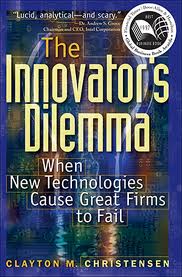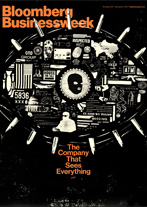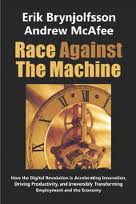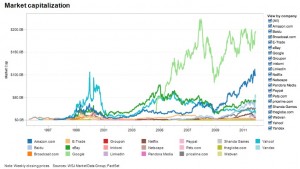
The Week in Geek™ – Dec. 1, 2011
Big Numbers, Questions Surround Latest Facebook IPO talk Good Morning Silicon Valley offers a great summary of some compelling stats on the rumored $10 billion 2012 Facebook IPO which may value the firm at $100 billion. It also provides a nice update for those teaching with my Facebook Case/Chapter. Among the highlights:
Good Morning Silicon Valley offers a great summary of some compelling stats on the rumored $10 billion 2012 Facebook IPO which may value the firm at $100 billion. It also provides a nice update for those teaching with my Facebook Case/Chapter. Among the highlights:
- For comparison, Google’s 2004 IPO raised $1.9 billion, valuing the firm at $23 billion.
- There have only been 13 IPOs that have raised at least $10 billion. The list includes Visa, GM and AT&T Wireless Services & none from a 7 year old firm started by a 19 year old.
- Facebook’s projected 2011 revenues of $4.27 billion are already bigger than Yahoo’s and growing at a much faster rate.
- A $100 billion valuation is 23 times Facebook’s projected ’11 revenues. For comparison: Google comes in at 6.5 times revenues, Apple at 2.6 times, and Microsoft at 2.8.
- This valuation would make Facebook worth more than all but four Silicon Valley tech firms: Apple (worth $350 billion), Google ($190 billion), Oracle ($152 billion), and Intel ($121.2 billion). More perspective: HP is valued at $54.5 billion & Cisco at $96.9 billion, and Seattle’s Microsoft and Amazon are worth $213 billion and $89 billion respectively.
- If these numbers hold up, Zuck would be worth about $24 billion. That compares to about $20 billion for Sergei and Larry of Google, $39.5 billion for Oracle’s Larry Ellison, and $56 billion for Bill Gates.
Click the image below for a neat WSJ interactive graphic comparing prominent tech IPO market capitalization growth.
Going public is a near certainty for Facebook next year. Since Facebook will cross the 500-shareholder limit later this year, it’ll be forced to make its financials public by April. And there’s little incentive to “open the kimono” to disclose financials to potential competitors without also using public markets to raise cheap capital and fuel expansion.
How will markets treat Facebook after the IPO? It’s tough to say. Facebook has potential in yet-to-be created businesses. As this blog has pointed out before, unlike Google, Facebook doesn’t yet have an ad network, and the appointment of Netflix CEO Reed Hastings to Facebook’s board was likely done as the firm considers baking Facebook into all sorts of consumer electronics, perhaps lucratively bringing social and ad targeting to television.
But this year’s tech IPOs haven’t done well after issue. Groupon was down 42% in the five days after it went public, and LinkedIn, whose stock doubled the first day of trading, has fallen 36% since then. Zynga, you’re up next, and Yelp will likely follow close behind.
On another note, Facebook recently settled with the FTC, agreeing to 20 years of privacy-related auditing.
The Empire Strikes Back – Big Firms Get Disruptive Being big can be brutal. In the past 10 years, 40% of the Fortune 50 have changed. Implosions have been dramatic and often tragic (think Sun, K-Mart, Enron). The list of stumbling giants rocked by technology disruption is a long one (Borders, Blockbuster, Nokia, Sony, RIM, the newspaper industry, the music business, and more). While their earlier research showed that smaller firms were most likely to disrupt giants, Scott Anthony and Clay Christensen (the Innosight team consulting team behind the latest books on “Innovator’s Dilemma”) are finding trends showing that an increasing number of big firms are learning to be disruptive, too.
Being big can be brutal. In the past 10 years, 40% of the Fortune 50 have changed. Implosions have been dramatic and often tragic (think Sun, K-Mart, Enron). The list of stumbling giants rocked by technology disruption is a long one (Borders, Blockbuster, Nokia, Sony, RIM, the newspaper industry, the music business, and more). While their earlier research showed that smaller firms were most likely to disrupt giants, Scott Anthony and Clay Christensen (the Innosight team consulting team behind the latest books on “Innovator’s Dilemma”) are finding trends showing that an increasing number of big firms are learning to be disruptive, too.
The team finds that while during the 1980s and 1990s, only about 25% of disruptive innovations came from big incumbents, during the last decade that number jumped to 35%. Anthony & Christensen offer several examples of the new incumbent innovators, including: GE’s undercutting its own high-end EKG equipment and developing low-end products for emerging markets. GM & Nissan developing affordable electric cars, potentially disrupting the business of oil companies. Dow Corning disrupting its own commission-based sales force by developing Xiameter, a self-service, Web-based distribution channel. While some of the examples might not fit exactly with the original Christensen definition of disruptive tech (lower performing products that become good enough to invade established markets), trends seem to show that giants recognize they need to continually innovate or risk extinction.
The search to enter developing markets that may value lower performing but far cheaper offerings, is one reason why big firms are thinking disruptively. Those wanting growth need to be willing to undercut their high-priced, over-featured mature-market offerings (e.g. the GE emerging market EKG). Authors cite three other factors seen among large firms that successfully transform through disruptive innovation: 1) Pushing beyond core competencies (think Amazon moving from e-commerce retail to develop an eBook reader, cultivate the eBook market, and become a leader in cloud computing). 2) Embracing business-model innovation (Apple, with iTunes, App Store, and Apple Retail as a poster child for success). And 3) Managing the old and the new differently (IBM evaluates Emerging Business Opportunities teams largely on whether managers learn from failure and respond with adjustments).
Palantir: The War on Terror’s Secret Weapon “It’s like plugging into the Matrix… The first time I saw it, I was like, ‘Holy crap. Holy crap. Holy crap.’ ” That was the reaction of an Afghanistan-based U.S. Special Forces operative when using software from Palo Alto-based Palantir (BusinessWeek once asked if the firm is “The Next Google?”). Based in the former digs of Facebook, and funded by In-Q-Tel (the CIA’s VC), Palantir has become the darling of intelligence agencies, law enforcement groups, and banks. The firm’s big trick is making sense of “Big Data” – offering tools that connect & mine the oceans of data produced by disparate and unconnected information technology. Says a Gartner analyst, ” The company’s software pulls off one of the great computer science feats of the era: It combs through all available databases, identifying related pieces of information, and puts everything together in one place.”
“It’s like plugging into the Matrix… The first time I saw it, I was like, ‘Holy crap. Holy crap. Holy crap.’ ” That was the reaction of an Afghanistan-based U.S. Special Forces operative when using software from Palo Alto-based Palantir (BusinessWeek once asked if the firm is “The Next Google?”). Based in the former digs of Facebook, and funded by In-Q-Tel (the CIA’s VC), Palantir has become the darling of intelligence agencies, law enforcement groups, and banks. The firm’s big trick is making sense of “Big Data” – offering tools that connect & mine the oceans of data produced by disparate and unconnected information technology. Says a Gartner analyst, ” The company’s software pulls off one of the great computer science feats of the era: It combs through all available databases, identifying related pieces of information, and puts everything together in one place.”
The firm’s customer list includes the U.S. Defense Dept., CIA, FBI, Army, Marines, Air Force, the police departments of New York and Los Angeles. The CEO of the National Center for Missing and Exploited Children says Palantir “gives us the ability to do the kind of link-and-pattern analysis we need to build cases, identify perpetrators, and rescue children.” Financial institutions are using the firm’s tools to ferret out bank fraud and shut down organized crime networks. The CIO of JPMorgan Chase says the firm’s technology turns “data landfills into gold mines.” The BusinessWeek cover story linked above offers a fictional national security example to illustrate Palantir’s abilities where a speeding ticket triggers an alert, allowing a name to be connected to fingerprint and DNA evidence gathered by CIA operatives, surveillance video from an ATM, shots of a rental truck’s license plate at a tollbooth, phone records, and map pinpointing suspect movements across the globe, all displayed on a “Mission Impossible”-style graphical display.
Anyone who’s worked at integrating databases knows how challenging it can be to link disparate systems, but Palantir claims they can be “up and running in a bank in eight weeks… instead of waiting two to three years with our competitors.” Palantir certainly is different from the Beltway Bandits that typically serve government agencies. The firm’s offices include murals of CareBears, teams of geeks wearing My Little Pony t-shirts, and CEO Alex Karp has a Ph.D. in Philosophy and studied under one of Europe’s leading neo-Marxists. Contrast this with the firm’s security staff, whose black gloves and Secret Service-style earpieces make “downtown Palo Alto feel, at times, a bit like Langley.”
Most clients are mum about specifics of their Palantir implementations, however the firm’s revenues have grown three fold a year, suggesting clients are impressed with what they’re getting. A typical deal ($5-$100 million) is paid for 20% upfront, the rest delivered only after the customer is satisfied.
This kind of access is a godsend to some, and creeps out others. Palantir tries to ease concerns, claiming its software creates audit trails, detailing who has seen certain pieces of information and what they’ve done with it, and that it has a permission system to make sure that staff can access only the data that their clearance levels allow. Still, it’s yet another example of technology advancing faster than law is able to balance issues of public safety and civil rights (for more on that topic see the recent broadcast of NPR’s Fresh Air on “Interpreting the Constitution in the Digital Era”
The Big Data Boom is the Innovation Story of Our Time MIT’s Erik Brynjolfsson & Andrew McAfee say that breakthroughs in innovation often rely on breakthroughs in measurement. And increasingly we’re measuring just about everything – web monitoring, app analytics, inventory hops via RFID, and more. But “Big Data” becomes valuable when it’s turned into “Big Information”. And tools like Palantir (above), the cloud, and the like are putting data crunching capabilities in the hands of the masses.
MIT’s Erik Brynjolfsson & Andrew McAfee say that breakthroughs in innovation often rely on breakthroughs in measurement. And increasingly we’re measuring just about everything – web monitoring, app analytics, inventory hops via RFID, and more. But “Big Data” becomes valuable when it’s turned into “Big Information”. And tools like Palantir (above), the cloud, and the like are putting data crunching capabilities in the hands of the masses.
The results are huge As Microsoft’s Ron Kohavi puts it “objective, fine-grained data are replacing HiPPOs (Highest Paid Person’s Opinions) as the basis for decision-making at more and more companies.” Firms aren’t just analyzing data they receive, they’re running A-B experiments to collect real-time insights for constant improvement. Our TechTrek students have heard this from Amazon’s P13N (personalization) team members. Says one Amazon exec: “To find high impact experiments, you need to try a lot of things. Genius is born from a thousand failures. In each failed test, you learn something that helps you find something that will work. Constant, continuous, ubiquitous experimentation is the most important thing.” Google (another TechTrek host) runs some 100-200 A-B-style experiments a day, trying out new products and services, tweaking algorithms and tinkering with designs.
Brynjolfsson & McAfee are also authors of the book Race Against the Machine, and were recently featured on a segment of NPR’s OnPoint Radio. Folks interested in a primer on data, analytics, and brief case studies on how firms like Tesco, Caesar’s Entertainment (formerly Harrah’s), and Wal-Mart use “Big Data” can also see the chapter “The Data Asset: Databases, Business Intelligence, and Competitive Advantage” from my book.
Inside P&G’s Digital Revolution Robert McDonald, Proctor & Gamble’s CEO, wants to make his firm “the most technologically enabled business in the world.” His interview in McKinsey Quarterly offers several examples. P&G employees help design their own operational “cockpit” interface. When metrics move outside acceptable tolerances an alarm goes off. Managers can then drill down, find out what’s going on, and make decisions based on this real-time data. The firm has a “baseline digital-skills inventory that’s tailored to every level of advancement in the organization.” Says the CEO, “we’ve got to have the standards for everyone because otherwise we’ll dumb the organization down to the lowest common denominator.” A believer in assessing the “consumer pulse” via social media, P&G managers also use monitoring tools to scan online mentions and puts relevant brand references front & center in real time.
Robert McDonald, Proctor & Gamble’s CEO, wants to make his firm “the most technologically enabled business in the world.” His interview in McKinsey Quarterly offers several examples. P&G employees help design their own operational “cockpit” interface. When metrics move outside acceptable tolerances an alarm goes off. Managers can then drill down, find out what’s going on, and make decisions based on this real-time data. The firm has a “baseline digital-skills inventory that’s tailored to every level of advancement in the organization.” Says the CEO, “we’ve got to have the standards for everyone because otherwise we’ll dumb the organization down to the lowest common denominator.” A believer in assessing the “consumer pulse” via social media, P&G managers also use monitoring tools to scan online mentions and puts relevant brand references front & center in real time.
P&G is also pioneering new financial systems, with McDonald stating “accounting systems aren’t designed today for operations—they tend to look backward.” But new efforts will link real-time operational systems to financial tools to allow managers to see product costs in real time, enabling more nimble decision-making. As one of the nation’s top trucking users, P&G also leverages data analysis to optimize its fleet, reducing so-called “deadhead” movement (empty or under-filled trucks) by roughly 15%.
When a study found that 70% of orders between retailers and suppliers had errors, P&G developed a common, sharable data warehouse that reduced ordering errors to “virtually zero” and saving millions of dollars. In order to ensure security and privacy when working with partners the firm establishes “very clear firewalls between one retailer and another and strict policies”, including an employee “cooling off” period in between projects with different retailers. Partner tools are adapting to emerging economy technology. For example, in nations like the Philippines, where smaller retail operators are more likely to use mobile phones than PCs, P&G has deployed mobile phone systems that allow retailers to order. Phone systems also make recommendations on store layout, with data-driven suggestions on how retailers can rearrange inventory to optimize their sales. Even the suds get the geek treatment. The firm’s R&D chemists have used computer modeling to predict how moisture would excite various fragrance molecules to deliver specific fragrance notes at specific stages in the washing cycle. This isn’t conventional lab work, it happens entirely in computer simulations. From all ends of the firm’s value chain, P&G is leveraging and embedding technology to drive results.
SANERGY TALK POSTPONED: But David will be back next semester – stay tuned:
Social Entrepreneurship Standout Sanergy On Campus
 Anyone interested in social entrepreneurship & how business principles can create sustainable good will want to hear David Auerbach speak at BC in Gasson 305 at 4;30pm on Dec. 7th.. Auerbach is co-founder of Sanergy, a firm that improves health conditions and quality of life by providing innovative toilets to desperately poor urban areas that lack plumbing. The ‘waste’ from their devices is turned into biogas & fertilizer that is then sold, with profits generating funds for more toilets. The firm has already deployed in slum areas of Nairobi Kenya. Come hear David’s compelling story. Sanergy is the winner of the prestigious MIT $100K and Mass Challenge $100K Diamond award. The firm also received a significant funding commitment from USAID.
Anyone interested in social entrepreneurship & how business principles can create sustainable good will want to hear David Auerbach speak at BC in Gasson 305 at 4;30pm on Dec. 7th.. Auerbach is co-founder of Sanergy, a firm that improves health conditions and quality of life by providing innovative toilets to desperately poor urban areas that lack plumbing. The ‘waste’ from their devices is turned into biogas & fertilizer that is then sold, with profits generating funds for more toilets. The firm has already deployed in slum areas of Nairobi Kenya. Come hear David’s compelling story. Sanergy is the winner of the prestigious MIT $100K and Mass Challenge $100K Diamond award. The firm also received a significant funding commitment from USAID.
The event is brought to you by BCSEED – The BCVC sub-group on social entrepreneurship. To learn more about BCSEED, the social entrepreneurship track of BCVC, & to get on the group’s mailing list, e-mail PlantChange@gmail.com and follow them on Twitter @bcseed.
◆ ◆ ◆ ◆
 More Student Press
More Student Press
The BC community may be interested in recent press coverage of several firms started by current and former students of mine…
- Boston Herald on BCVC ’11 Winners Jebbit.com: “Startup helps brands get more bang on Web.” Follow the team on Twitter: @jebbitinc @petercasinelli @tomcoburn1 @Jebthomas
- Boston Business Journal on Applied Power Innovations: “Class Act: Product monitors energy usage by the dashboard light“. You can see Rich & CJ (BCVC exec committee & TechTrek ’12) in this year’s Boston College PSA, and can follow the team on Twitter: @apinnovations @CJ_Reim @richrines
- CNet covers Bill Clerico (TechTrek Alum & BCVC co-founder) & Rich Aberman’s WePay “WePay planning…” an astonishing, break out year. Follow @WePay @billclerico @richaberman
- BostInnovation covers TechTrek alum Phil Dumontet: “Dash Deliveries: Bringing Boston’s Best Food To Your Doorstep in 45 Minutes or Less“. Dash is expanding to 6th city this month, all without raising any venture capital! Follow Phil on Twitter: @PhilipDumontet
Keep at it, Eagle Entrepreneurs & be sure to visit http://bcvc.org & follow @BostonCollegeVC.
And as an extra bonus for folks interested in campus activities, check out BC Chronicle coverage of the new BCTalks series – TED-like lectures by our undergrads; and see BostInnovation press & BC Heights coverage of the latest BC Splash, where over 150 BC students designed and taught weekend lectures for over 800 visiting high school students. I’m hugely honored to be faculty advisor to both efforts. For more info see the web pages for BC Splash and BCTalks.
◆ ◆ ◆ ◆
Aniphon: Coming Soon! For the past few weeks two of my kids (Ian, age 11, and Maya, age 6) have been beta-testing a new iOS game called Aniphon created by Moglo Apps. And every day since we’ve got the super-secret beta, the kids have woken me up each morning, asking to play this game. Some of you may know Moglo as a finalist in last year’s Boston College Venture Competition. Matt Ricketson, ’13, a lifelong Apple fanboy, skipped a dream internship on Apple’s mobile development team, opting instead to work on Aniphon (that’s commitment & belief in what you’re building). John Bacon, ’12, wrote his first Android app while in high school & gave a recent BC Talks lecture on entrepreneurship. Spencer Frazier ’11, is now a Comp. Sci. Ph.D. student at USC. The team has chops (Matt & John are also TechTrek alums). If you’ve got an iOS device, you’re a gamer, or know someone who is, sign up for release info at http://aniphon.com. You can also follow the team on Twitter: @aniphon, @ricketsm, @JohnABacon, & @spencerfrazier. The team will let you know as soon as the app is approved by Apple & available in the App Store. Until then, I remain mum even as I struggle to regain control of my phone from my Aniphon-fanatic kids.
For the past few weeks two of my kids (Ian, age 11, and Maya, age 6) have been beta-testing a new iOS game called Aniphon created by Moglo Apps. And every day since we’ve got the super-secret beta, the kids have woken me up each morning, asking to play this game. Some of you may know Moglo as a finalist in last year’s Boston College Venture Competition. Matt Ricketson, ’13, a lifelong Apple fanboy, skipped a dream internship on Apple’s mobile development team, opting instead to work on Aniphon (that’s commitment & belief in what you’re building). John Bacon, ’12, wrote his first Android app while in high school & gave a recent BC Talks lecture on entrepreneurship. Spencer Frazier ’11, is now a Comp. Sci. Ph.D. student at USC. The team has chops (Matt & John are also TechTrek alums). If you’ve got an iOS device, you’re a gamer, or know someone who is, sign up for release info at http://aniphon.com. You can also follow the team on Twitter: @aniphon, @ricketsm, @JohnABacon, & @spencerfrazier. The team will let you know as soon as the app is approved by Apple & available in the App Store. Until then, I remain mum even as I struggle to regain control of my phone from my Aniphon-fanatic kids.
◆ ◆ ◆ ◆
NOTE: Faculty using my book – version 1.3 of “Information Systems: A Manager’s Guide to Harnessing Technology” will be available in December, ready to ship to bookstores for the start of the Spring 2012 semester. The new version will include a significantly updated Netflix chapter, covering the rise & fall of Qwikster and detailing the differences between the atoms & bits based businesses. The Google chapter will also include coverage of the Motorola acquisition and Google+. Contact your FlatWorldKnowlege sales rep for details. The text will continue to remain free online, and I’ll be sure to share links as soon as updates are online. Feel free to check out v. 1.2 in the meantime, and please share information about the project with your colleagues. Thanks!


